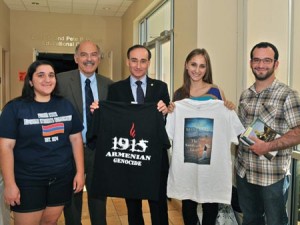Suren Oganessian
Staff Writer

Photo: Raffi Mouradian
Can a NYTimes Bestselling novel raise awareness about the Genocide and be entertaining? The answer is yes, and Chris Bohjalian, author of The Sandcastle Girls, visited Fresno State on April 14, 2013, to share just how he wrote such a novel.
The novel is about the romance between an American nurse and an Armenian engineer set against the backdrop of the Armenian Genocide in 1915. The story is told through the eyes of their granddaughter, Laura Petrosian, who tries to piece together their history.
Bohjalian is the author of sixteen novels, including New York Times bestsellers The Double Bind, The Night Strangers, and Midwives, which became a number one bestseller and was chosen for Oprah’s Book Club. Bohjalian graduated from Amherst College in Massachusetts, and currently resides in Lincoln, Vermont.
Fresno was Bohjalian’s first stop on a tour launching the paperback edition of The Sandcastle Girls. His talk was cosponsored by the Armenian Studies Program, the Armenian National Committee, of America, and publisher Doubleday. Bohjalian’s lecture, held in a packed Leon and Pete Peters Educational Center Auditorium, focused on his childhood, his travels in the Middle East, and just what had inspired him to craft such a gripping story about the Armenian Genocide.
Writing The Sandcastle Girls was, for Chris Bohjalian, a rediscovery of his soul. In doing research for the novel he embarked on a tour of Armenian landmarks of the Middle East, visiting Lebanon and also Armenia. He was particularly moved when visiting Anjar, Lebanon, where the refugees from the Musa Dagh resistance resettled.
On a mural painted at one of their cathedrals was the phrase “Let them come again, we are still the mountain.” Bohjalian interpreted this as saying no matter where we go on this planet, Armenians everywhere will always be a part of “the mountain,” be it Musa Dagh or Ararat.

and Marine Vardanyan in front of the Saroyan Theatre.
Photo: Raffi Mouradian
As Bohjalian put it, “These two mountains are an inseparable part of the geography of the Armenian soul.” It was inspiration from that phrase which, in part, helped him to write what he calls “the most important story I will ever write.”
Bohjalian is the grandson of Armenian Genocide survivors who had immigrated to America. His father was Armenian and his mother Swedish; paradoxically however, he learned more about his Armenian heritage from his mother than his father, spent his entire life striving to integrate himself into American culture.
His mother loved her in-laws however, and became enamored with Armenian culture. Another major draw to his Armenian heritage from an early age was, unsurprisingly, the food. After purchasing an Armenian cookbook that contained stories and anecdotes along with recipes, Bohjalian had his first urge to try and tell the story of what had happened to his ancestors in 1915.
Bohjalian’s first attempt at creating an Armenian Genocide narrative in 1993 was, in his words, “a train wreck.” He said that it lacked a gripping plot and engaging characters, and was more of a documentary than a story. And at the time he was writing it, Carol Edgarian’s Rise the Euphrates was released, causing Bohjalian to conclude that the world already had a beautifully written Armenian Genocide narrative and didn’t need his.
Bohjalian didn’t make another attempt to write a genocide novel for 17 years, until his friend Khatchig Mouradian encouraged him to. This time, settling on the idea of weaving a romance into the history, Bohjalian was much more successful, and the novel has found an audience with people who never heard of the Armenian Genocide and would be hard-pressed to even find Armenia on a map.
Bohjalian said that some people told him that he was “losing his mind” and that no one would want to read it.
Fortunately, this was far from the case, in part thanks to powerful marketing from Armenian organizations such as the ANCA and the AGBU.
 Hye Sharzhoom Armenian Action
Hye Sharzhoom Armenian Action